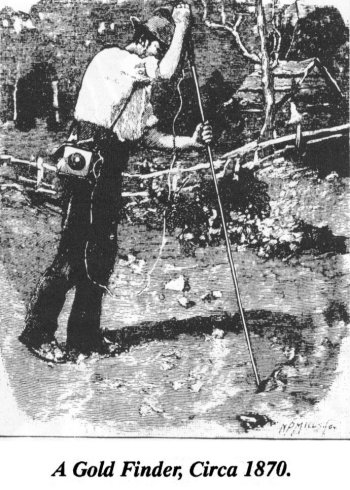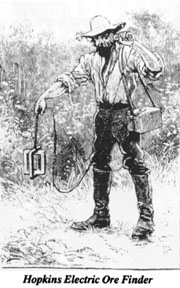BY DICK TURNER
A chronological account of the development of treasure and gold locators from 1830 to 1930.
 As all gold hunters know, we are blessed with high-technology instruments to aid our searches for precious metals. Nuggets can be identified in a highly mineral matrix, thus eliminating unnecessary digging of unwanted material, and the Goldspear will locate even gold dust. However, none of these sophisticated detectors appeared overnight, nor was any one man responsible for the invention of metal detection.
As all gold hunters know, we are blessed with high-technology instruments to aid our searches for precious metals. Nuggets can be identified in a highly mineral matrix, thus eliminating unnecessary digging of unwanted material, and the Goldspear will locate even gold dust. However, none of these sophisticated detectors appeared overnight, nor was any one man responsible for the invention of metal detection.
THE PIONEER
If any one person could be regarded as the inventor of metal detectors, I will nominate English geologist and mining engineer R. W. Fox. It was Fox who first discovered that electricity will flow through metallic ores as well as solid metal objects. Thus, circa 1830 he devised a simple metal locator which consisted of nothing more than a battery, several metal rods and a suitable length of wire. His first method of detection was as follows: one metal rod would be driven into the earth where the suspected vein of ore was located; it was connected to one terminal of the battery. The other battery terminal was connected to a floating wire. Other metal rods were driven into the ground at several different points and successively touched with the floating wire. Where a spark occurred, it was an indication that metal was present. Circa 1870, this device was modified to two rods insulated from each other in a common probe and connected via battery to a bell and plunged into the earth. When contact was made by metallic ore, nugget or metal pipe, the bell rang, thus indicating the presence of a conductive object.
THE INDUCTION BALANCE
 In 1879, Professor D.E. Hughes demonstrated to the Royal Society in London his Induction Balance (I.B.). Its purpose was to study the molecular structure of metals and alloys. However, Hughes and his instrument maker, William Groves, soon recognized the potential of the I.B. as a metal locator, and several were supplied to various London Hospitals for locating metal objects in human bodies. The Royal Mint used the Induction Balance for assaying metals and detecting forgeries.
In 1879, Professor D.E. Hughes demonstrated to the Royal Society in London his Induction Balance (I.B.). Its purpose was to study the molecular structure of metals and alloys. However, Hughes and his instrument maker, William Groves, soon recognized the potential of the I.B. as a metal locator, and several were supplied to various London Hospitals for locating metal objects in human bodies. The Royal Mint used the Induction Balance for assaying metals and detecting forgeries.
The well- known American inventor George Hopkins modified the I.B. for locating metallic ores, treasure chests and the like. In fact, the Induction Balance forms the basis of most metal detectors we use today.
FURTHER DEVELOPMENTS
On June 21, 1902, the London Electric Ore Finding Company filed an application at the British Patent Office for an entirely new type of metal detector. This was a very advanced instrument for its time, having a range of one hundred yards. It operated as follows: a bank of batteries supplied a high-voltage, heavy-duty current to a spark generator; its output was chopped by a motorized contact breaker to achieve a signal at audio frequency, which in turn was fed to two transmitter probes driven into the earth. At a suitable distance away, two similar probes were connected to receiving apparatus, and equipotential lines of conducting material (ores or solid metal objects) could be plotted.
 This company also developed an underwater spear-type detector which was used in locating gold bars in the wreck of the LAURENTIC, which was torpedoed during World War 1. This was a discriminating-type detector which could distinguish between gold and other metals. Unfortunately, the patent specifications are very brief and no illustrations are enclosed, hence we lack full information of how this detector worked.
This company also developed an underwater spear-type detector which was used in locating gold bars in the wreck of the LAURENTIC, which was torpedoed during World War 1. This was a discriminating-type detector which could distinguish between gold and other metals. Unfortunately, the patent specifications are very brief and no illustrations are enclosed, hence we lack full information of how this detector worked.
Electric Metal Locating Company of Chicago took a different approach to metal detection, and based their instrument on the Wheatstone Bridge principle with two ground probes as sensors. A similar principle was employed by another American inventor Fred H. Brown who, in one of his patents, actually specifies his detector as being suitable for locating buried treasure.
THE WIRELESS AGE
With the very rapid development of wireless techniques during World War I, it was only natural that this technique would be adapted to metal locators and prospecting equipment. One of the first pioneers to exploit this technology for locating buried treasure was Englishman George Williams, who was the wireless operator aboard the salvage ship RACER during the recovery of gold from the wreck of the LAUREN TIC. Being fully conversant with wireless techniques, and seeing the somewhat primitive treasure locators available then, he decided he could improve the existing technology by designing a Radio-Locator (as metal detectors were known then).
In the book, “DIG FOR PIRATE TREASURE,” the author states that, “Williams had a metal detector of his own invention and used it to good advantage in Panama.” This surely must be the greatest understatement ever made relating to buried treasure. Further on, the author goes on to say that Williams “unearthed some wonderful stuff, including gold pots, candlesticks, silver bells and many historical things. A solid gold ball seven inches in diameter with a cross on top and gold leaves underneath.”
On January 7, 1928, The London Times newspaper reported that Williams found “a solid gold altar two feet high,” while C. B. Driscoll in DOUBLOONS expands the finds list even further. He also describes the Williams’ detector as a Transmit-Receive instrument operating at radio frequency. Williams, with his locator, arrived in Panama in July 1925, hence he certainly was one of the pioneers of T-R technique (see author’s note).
At approximately the same period of time, Radiore Company of Los Angeles developed a large-scale metal prospecting apparatus operating at fifty kilohertz.
Circa 1926, SCIENCE AND INVENTION magazine published construction articles under the title, “The Radio Gold Explorer.” So we see that even amateur gold hunters were catered to. By the mid-1930’s, there was an abundance of gold and treasure locators, the most notables being: the Alpha by George Maher, Terrasearch from Engineering Research Corporation, Radioscope by Goldak, Inc.; and, of course, Metalloscope from Gerhard Fisher. The Metalloscope was undoubtedly the most popular treasure finder of all time having survived in continuous production right up to the solid-state era, hence the M-scopes of the current Fisher line of detectors.
AUTHOR’S NOTE: In this article, I have attempted to give historical development of metal detection during the first 100 years of the use of electricity and electronics for this purpose, although other devices, mechanical (Dip Needle/Miners Compass) or physical (Pendulums/Divining Rods) were in use for several hundred years prior. As no reference books are available on this subject, I have relied on patents and articles published elsewhere to gain the necessary information. However; there are large gaps in my knowledge. For instance, the technical information and illustrations of the George Williams’ detector. I would be very pleased to hear from anybody who can supply further information. Please write to me direct at: 34 Nelson Gardens, London E2 7M, England.





